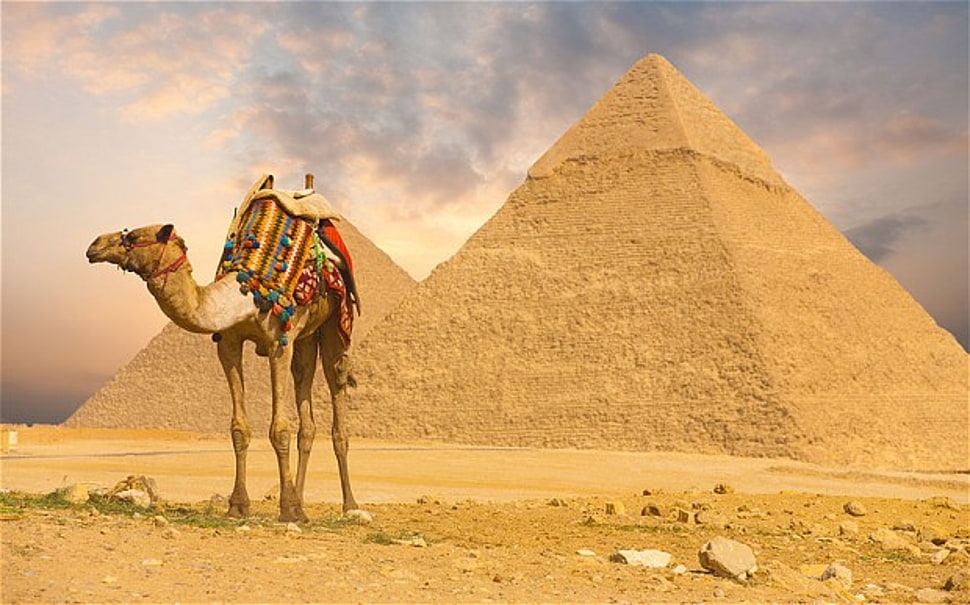MEXICO
CHICHÉN ITZÁ
The Mayan's Dedication to the Sun God.

History
The most famous and best restored of the Yucatán Maya sites, Chichén Itzá, while tremendously overcrowded – every gawker and his or her grandmother is trying to check off the new seven wonders of the world – will still impress even the most jaded visitor. Yes, it's goose bump material. Many mysteries of the Maya astronomical calendar are made clear when one understands the design of the ‘time temples’ here. Other than a few minor passageways, climbing on the structures is not allowed.
Facts
- Chichen Itza is classified as one of the New Seven Wonders of the World and in 1988 was enlisted as an UNESCO World Heritage Site.
- The term Chichen Itza means ‘the mouth at the well of Itza’. It is believed Itza means ‘water magicians’, deriving from the Mayan Itz for ‘magic’ and á for ‘water’.
- El Castillo (the Temple of Kukulkan) is the famous pyramid which dominates the site of Chichen Itza and it actually sits on another much older temple.
- Believed by archaeologists to have been a powerful economic city around 600 AD, the fall of Chichen Itza is thought to have been approximately 1000 AD.
- The design and layout of Chichen Itza was clearly well planned and builders constructed temples and pyramids in sets of clusters.
- The four most well known clusters are the Great North Platform, the Ossario Group, the Central Group and the Old Chichen, which is not open to the public. The Great North Platform is home to the most visited sites of Chichen Itza, including the Kukulkan Pyramid, the Great Ball Court and the Temple of the Jaguars.
- During the Spring (20th of March) and Autumn Equinox (22nd September), sunrays creates a shadow across the Kukulkan Pyramid that gives the appearance of a serpent slithering down the staircase.
- Located on the north side of the Kukulkan Pyramid is a platform dedicated to the planet Venus. The Mayans were devoted astronomers and the movements of Venus held special meaning to them, with it influencing the architecture of the ancient Mayan city Uxmal.
- Although the Kukulkan Pyramid is the most famous and most visited, there are numerous others in Chichen Itza. The Osario is very similar but smaller in size and at the centre is an opening to a natural cave.
- Many of the sites in Chichen Itza are known for their unusual sounds. If you clap once from one end of the Ball Court, it produces nine echoes in the middle of the court. Additionally, a clap in front of the Kukulkan Pyramid creates an echo resembling the serpent’s chirp.


BRAZIL
Christ
the Redeemer
A Symbol of Peace and Love.

History
The colossal statue of Jesus Christ at the summit of Mount Corcovado, Rio de Janeiro, southeastern Brazil. It was completed in 1931 and stands 98 feet (30 metres) tall, its horizontally outstretched arms spanning 92 feet (28 metres). The statue, made of reinforced concrete clad in a mosaic of thousands of triangular soapstone tiles, sits on a square stone pedestal base about 26 feet (8 metres) high, which itself is situated on a deck atop the mountain’s summit. The statue is the largest Art Deco-style sculpture in the world and is one of Rio de Janeiro’s most recognizable landmarks.
Facts
- Christ the Redeemer is the largest art deco statue in the world. It is 98 feet tall (not including the 26 foot pedestal), and the arms stretch to 92 feet wide.
- The statue weighs approximately 635 tonnes.
- Christ the Redeemer is located in the Tijuca Forest National Forest, at the top of the Corcovado Mountain.
- The statue is considered an icon of Rio de Janeiro and Brazil.
- Christ the Redeemer is the 5th largest statue of Jesus.
- The first suggestion to build a large religious monument was made in the 1850s by a Catholic priest names Pedro Maria Boss. The request for financing wasn't approved because Princess Isabel was not a fan of the idea. The request was officially denied in 1889 when Brazil mandated the separation of church and state. A petition started by a group in the early 1920s, called the Catholic Circle of Rio, was successful. Construction began in 1922 and took nine years to complete.
- The money to build Christ the Redeemer came from Brazil's Catholic community.
- There were several designs to choose from. One was a depiction of the Christian cross. Another was a statue of Jesus holding a globe, while standing over a pedestal that was to symbolize the world.
- The stones that were used to build Christ the Redeemer came from Sweden.
- The right arm points to south Rio de Janeiro and the left arm points to north Rio de Janeiro.


ITALY
The Colosseum
The Infamous Ampitheatre of Ancient Rome.
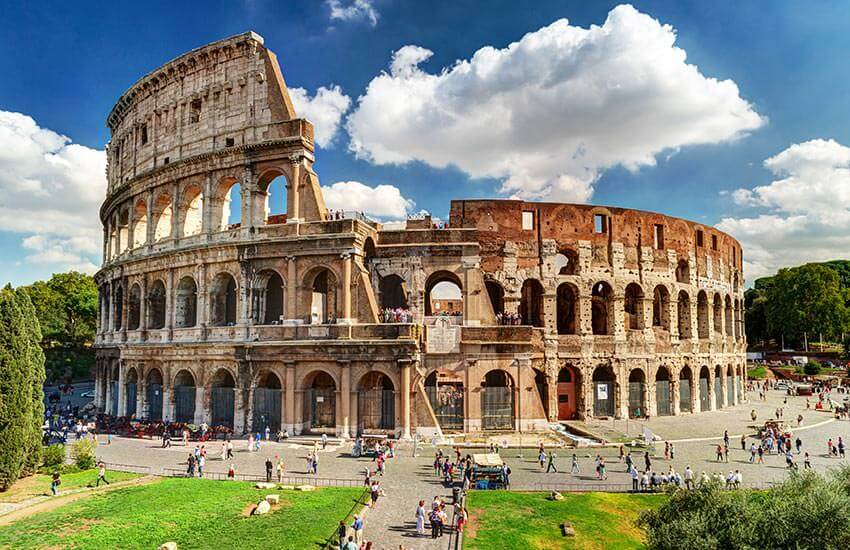
History
Rome’s great gladiatorial arena is the most thrilling of the city's ancient sights. Inaugurated in AD 80, the 50,000-seat Colosseum, also known as the Flavian Amphitheatre, was clad in travertine and covered by a huge canvas awning held aloft by 240 masts. Inside, tiered seating encircled the arena, itself built over an underground complex (the hypogeum) where animals were caged and stage sets prepared. Games involved gladiators fighting wild animals or each other.
Facts
- The Colosseum was built between 72 A.D and 80 A.D under the Emperor Vespasian, in the heart of Ancient Rome.
- Made from stone and concrete, this magnificent monument was built with the man power of tens of thousands of slaves.
- The Colosseum is the largest amphitheater (meaning “theatre in the round”) in the world! Oval in shape, it measures 189m long, 156m wide and 50m high (about the height of a 12 storey building). This ancient sporting arena could easily fit a modern day football pitch inside.
- This brilliant building had 80 entrances and could seat approximately 50,000 spectators who would come to watch sporting events and games. These events included gladiatorial combats, wild animal hunts and, believe it or not, ship naval battles.
- At the Colosseum’s major events – often those organised and paid for by the emperors themselves – there was no entry fee. And free food was sometimes served, too. Bonus! Emperors would use this as a way to gain popularity and support from the public.
- The events at the Colosseum were seriously brutal, though – during certain games held by the emperors around 10,000 animals were killed in a single day.
- The first games ever to be held were in 80 A.D, under Emperor Titus (the son of Vespasian), and they ran for 100 days straight. Games continued to be held for centuries to come – gladiatorial games until the fifth century and animal hunts until the 6th century.
- To protect the spectators from the blistering sun and heat of Ancient Rome, there was the velarium – an awning that could be pulled over the top of the seating area to provide shade. Clever, eh?
- Below the Colosseum were numerous rooms and underground passages. Here is where the animals and gladiators were kept, waiting to meet their fate in the arena above. There were also 36 trap doors in the arena for special effects!
- Although two-thirds of the colosseum has been destroyed over time – mostly the result of vandalism, earthquakes and fires – it is today a popular tourist site, attracting thousands of people every year!


INDIA
Taj Mahal
An Emperor's Labor of Love.

History
The Taj was built by Shah Jahan as a memorial for his third wife, Mumtaz Mahal, who died giving birth to their 14th child in 1631. The death of Mumtaz left the emperor so heartbroken that his hair is said to have turned grey virtually overnight. Construction of the Taj began the following year; although the main building is thought to have been built in eight years, the whole complex was not completed until 1653. Not long after it was finished, Shah Jahan was overthrown by his son Aurangzeb and imprisoned in Agra Fort, where for the rest of his days he could only gaze out at his creation through a window. Following his death in 1666, Shah Jahan was buried here alongside his beloved Mumtaz.
Facts
- For the transportation of the construction materials, more than 1,000 elephants were employed.
- As many as 28 different varieties of semi-precious and precious stones were used to adorn the Taj with exquisite inlay work.
- Depending on what time of the day it is and whether or not there’s moon at night, Taj Mahal appears to be of different color every time. Some even believe that this changing pattern of colors depict different moods of a woman.
- Passages from Quran have been used as decorative elements throughout the complex.
- On the sides of the actual tomb of Mumtaz Mahal, 99 names of Allah can be found as calligraphic inscriptions.
- Taj Mahal was built in stages, with the plinth and the tomb taking up roughly 15 years. Building of minarets, mosque, jawab, and gateway took additional 5 years to be completed.
- Different types of marbles used in construction of Taj Mahal were brought over from many different regions & countries: Rajasthan, Punjab, China, Tibet, Afghanistan, Srilanka, & Arabia.
- Many precious stones and Lapis Lazuli (a semi-precious stone) were ripped off from its walls by the Britishers during the Indian rebellion of 1857.
- Taj Mahal attracts 2-4 million visitors annually with over 200,000 from overseas.
- The full height of the Taj Mahal is 171 metres (561 feet).

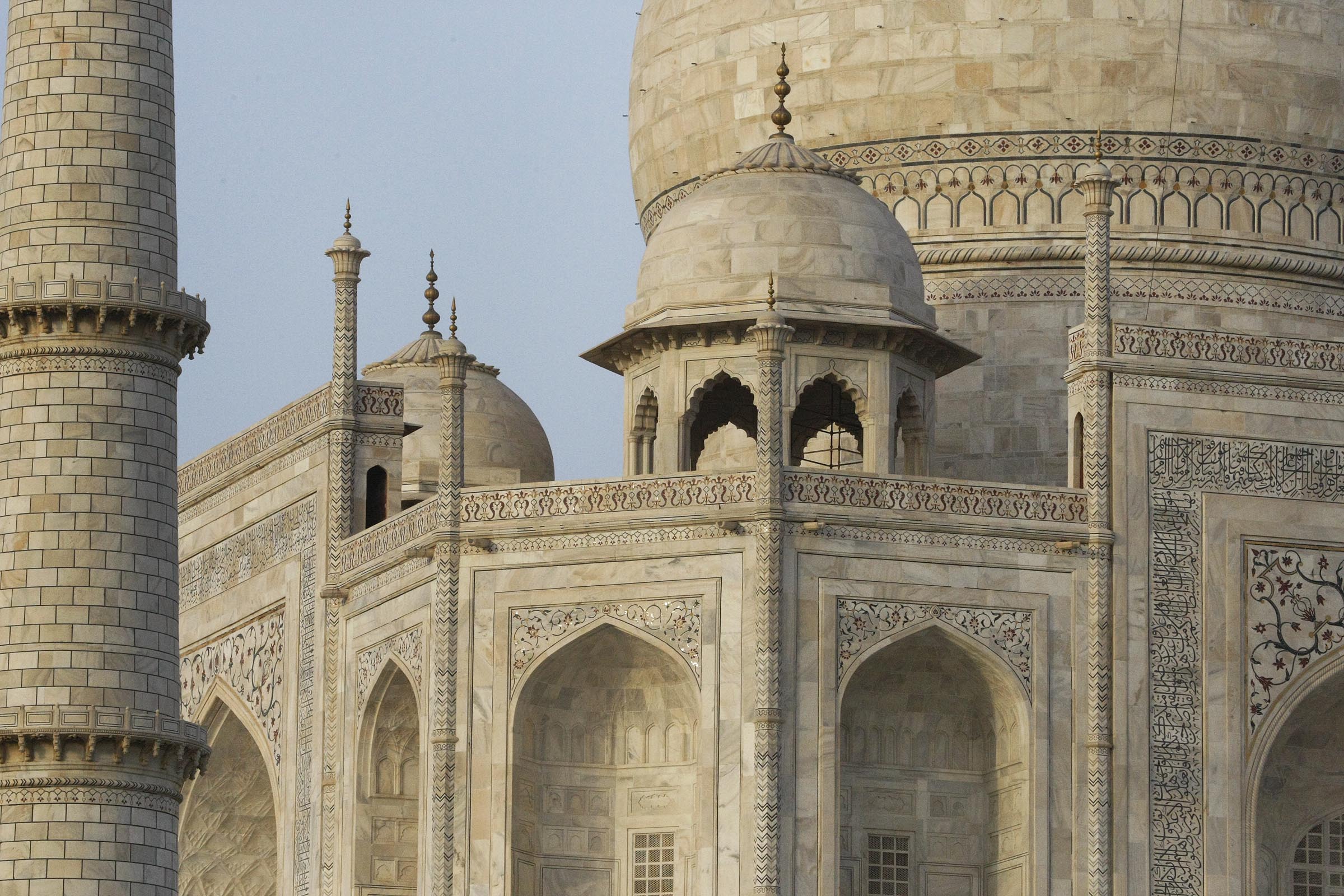
CHINA
THE GREAT WALL
The Grand Protector of Imperial Dynasties.
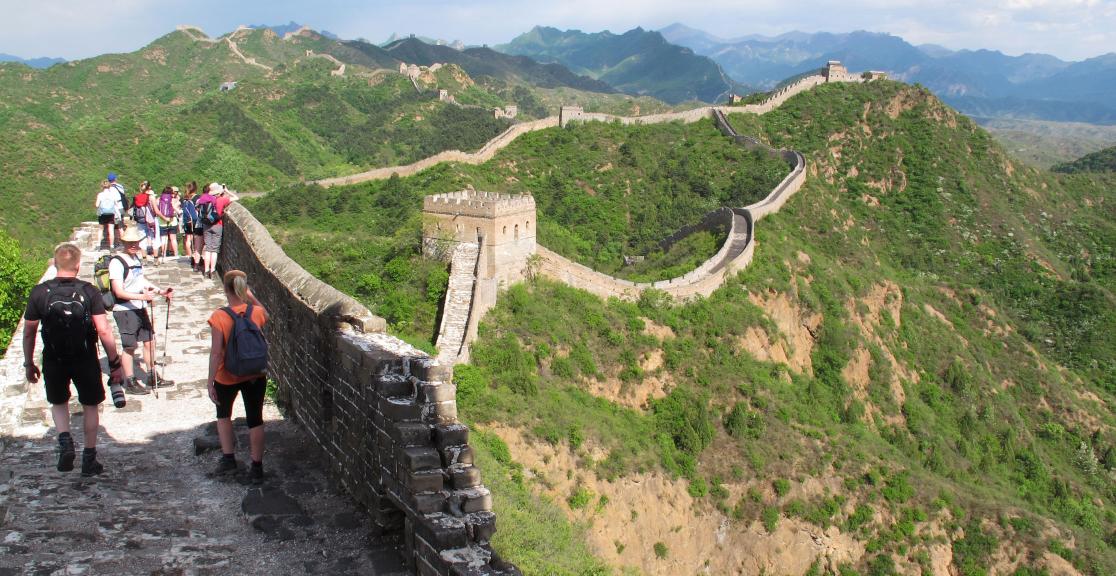
History
China’s greatest engineering triumph and must-see sight, the Great Wall (长城; Chángchéng) wriggles haphazardly from its scattered Manchurian remains in Liáoníng province to wind-scoured rubble in the Gobi desert and faint traces in the unforgiving sands of Xīnjiāng. The most renowned and robust examples of the Wall undulate majestically over the peaks and hills of Běijīng municipality, but the Great Wall can be realistically visited in many north China provinces. It is mistakenly assumed that the Wall is one continuous entity; in reality, the edifice exists in chunks interspersed with natural defences (such as precipitous mountains) that had no need for further bastions.
Facts
- Contrary to common belief, the Great Wall of China cannot be seen from space with the naked eye. It can be seen with aid.
- As early as the Qin Dynasty (221-207BC) when building the Great Wall, glutinous rice flour was used in making the binding material to bind the bricks.
- The sections of the Great Wall that we mostly associate with The Great Wall of China were built by the Ming Dynasty. This was the last part of the wall that was built and has been made with brick and features many tall watch-towers.
- The Great Wall of China has been called the longest cemetery on Earth. Over a million people died building the Wall and archaeologists have found human remains buried under parts of the wall.
- Although the official number of the length of the Great Wall is 8851.8 kilometers (5500 miles), the length of all the Great Wall built over thousands of years is estimated at 21,196.18 kilometers (13,170 miles). The circumference of the Equator is 40,075 kilometers (24,901 miles).
- The Great Wall of China is threatened with erosion. The northwestern sections (e.g. in Gansu and Ningxia provinces) of the Great Wall are deteriorating so quickly. It is believed that these sections may disappear within 20 years, due to demolishment by nature and human.
- Over 10 million people visit the Great Wall of China every year. The most famous section of the Great Wall-Badaling, had been visited by over 300 heads of state and VIPs from around the world, the first of which was Soviet. But it is also the busiest section of wall which is restored. If you are a hiker who like to see the real unspoiled Great Wall which is off the beaten path, we don’t suggest you go there.
- During the Cultural Revolution (1966-1976), many bricks of the Great Wall were taken away to use in building homes, farms or reservoirs. Otherwise many sections of the Great Wall would be preserved much better than what they are like today.
- The Great Wall is wide enough in some places to drive a car over it.
- The most well known of all of the legends of The Great Wall of China is the story of "Men Jiangnu’s Bitter Weeping" whose husband died building the wall. Her weeping was so bitter that a section of the wall collapsed, revealing her husband’s bones so she could bury them.


JORDAN
CITY OF PETRA
The Rose City of the Jordan Desert.
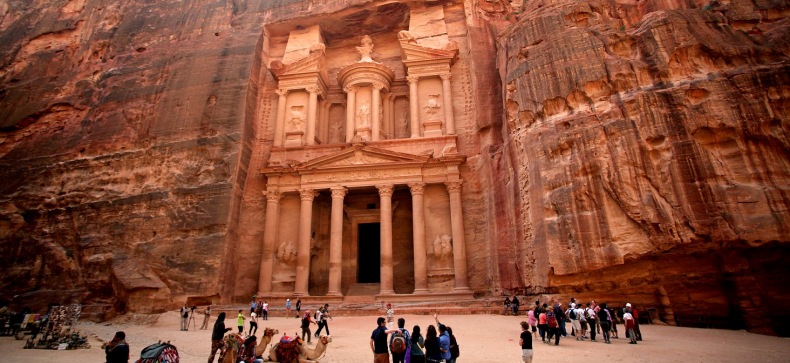
History
Petra, the great Ancient City that lies half-hidden in the wind-blown landscape in southern Jordan, is one of the world's most treasured Unesco Heritage Sites. Voted by popular ballot in 2007 as one of the 'New Seven Wonders of the World', it has retained its magnetism even through times of strife in the wider region.
Facts
- Among the Petra's amazing architecture, The Treasury is the most popular. It is estimated to be over 2,000 years old.
- The Bedouin of the Arabian Desert have destroyed some of the most priceless carvings on the Treasury's walls. They used the carvings as target during their shooting practice.
- The structures on most of the Petra Archaeologicalsite have been weakened by the salt that is blown from the dead sea and which crystalizes on the building's columns.
- Petra is though to have been built during the Byzantine Era of the 5th and 6th AD when Petra became an important Christian center.
- Petra is home to over 800 carved tombs.
- Petra is more popular for its 800 individual monuments that includes buildings, tombs, baths, funerary halls, temples, arched gateways, and colonnaded streets, that were mostly carved from the kaleidoscopic sandstone.
- The city was first established in 312 BC; making it one of the oldest metropolises in the world.
- It is in Petra that King Aretas called for the arrest of the biblian Apostle Paul after he was converted into Christianity.
- Among the most popular monuments in Petra is the 2,100-pound sandstone bust of Dushara, Petra’s primary male deity.
- Petra is one of the evidence to Mankind that Middle East was after all the most influential region of the world in the Middle Ages.


PERU
MACHU
PICCHU
The Lost Mystery of the Incas.

History
For many visitors to Peru and even South America, a visit to the Inca city of Machu Picchu is the long-anticipated highpoint of their trip. In a spectacular location, it’s the best-known archaeological site on the continent. This awe-inspiring ancient city was never revealed to the conquering Spaniards and was virtually forgotten until the early part of the 20th century. In the high season, from late May until early September, 2500 people arrive daily. Despite this great tourist influx, the site manages to retain an air of grandeur and mystery, and is a must for all visitors to Peru.
Facts
- Machu Picchu was built in the mid 15th century (1450s), during the reign of Incan emperor Pachacuti (1438–1472).
- The name Machu Picchu means Old Peak in Quechua.
- The site was abandoned approximately 120 years after it was built, most likely due to the outbreak of smallpox, a disease that was introduced to the local population with the arrival of the Spanish.
- The exact purpose of the site is still unknown, but it is thought to have either been a site of great spiritual importance, or served as a country estate for the emperor. Most academics fall into the second school of thought, although sites along the Inca Trail suggest that it may have also served as a spiritual retreat to honour nature.
- The ruins sit at 2,430m (7,970 feet) above sea level.
- The stones that were used to build the 200 or so buildings at Machu Picchu were created from a quarry nearby the city. The ashlar technique was a critical design feature that provided additional building strength for the city which was built in an earthquake-prone area.
- Most of Machu Picchu was constructed in the Classical Inca style with dry polished walls. The Incas were masters of the construction technique called ashlar, in which stones are cut and moulded to fit together perfectly, without the use of mortar. Some stone features in Machu Picchu are so perfect that it is difficult to even insert a blade of grass between them.
- Machu Picchu is Peru’s most popular tourist attraction. Just short of 1.2 million people visited Machu Picchu in 2013, a 700% increase from the early 1980s where the annual average number of visitors was 100,000. More than two thirds of the visitors to Machu Picchu are foreigners as opposed to Peruvians who account for just under one third of visitors.
- Machu Picchu is divided into an urban and agricultural sector, and an upper and lower town. The upper town on the Western section was the religious area, and the lower town on the eastern section the residential area.
- The structures within Machu Picchu were also constructed in a style that would protect the integrity of the building in the event of an earthquake. Doors and windows are trapezoidal in shape, tilting inwards for strength.


EGYPT
Great Pyramid of Giza
A Monumental Artifact of Hardship.
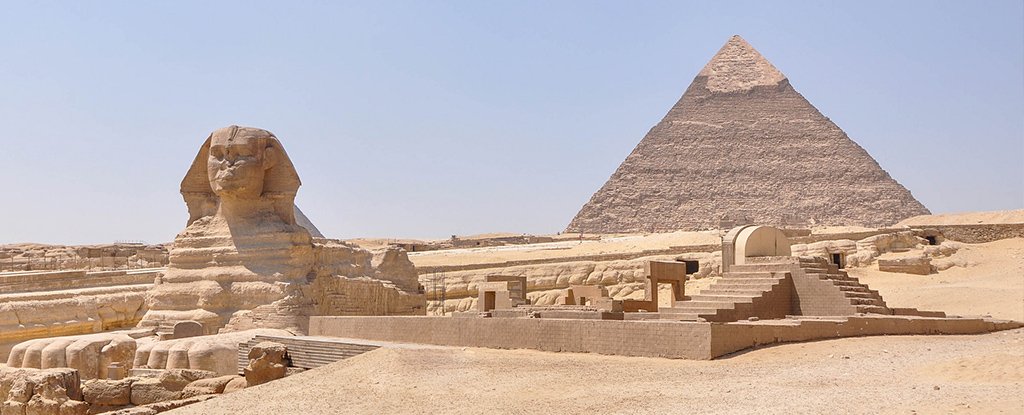
History
The last remaining wonder of the ancient world; for nearly 4000 years, the extraordinary shape, impeccable geometry and sheer bulk of the Giza Pyramids have invited the obvious questions: ‘How were we built, and why?’. Centuries of research have given us parts of the answer. Built as massive tombs on the orders of the pharaohs, they were constructed by teams of workers tens-of-thousands strong. Today they stand as an awe-inspiring tribute to the might, organisation and achievements of ancient Egypt.
Facts
- The pyramid is estimated to have around 2,300,000 stone blocks that weigh from 2 to 30 tons each and there are even some blocks that weigh over 50 tons.
- The Pyramid of Menkaure, the Pyramid of Khafre and the Great Pyramid of Khufu are precisely aligned with the Constellation of Orion.
- The base of the pyramid covers 55,000 m2 (592,000 ft 2) with each side greater than 20,000 m2 (218,000 ft2) in area.
- The interior temperature is constant and equals the average temperature of the earth, 20 Degrees Celsius (68 Degrees Fahrenheit).
- The outer mantle was composed of 144,000 casing stones, all of them highly polished and flat to an accuracy of 1/100th of an inch, about 100 inches thick and weighing approx. 15 tons each.
- The cornerstone foundations of the pyramid have ball and socket construction capable of dealing with heat expansion and earthquakes.
- The mortar used is of an unknown origin (Yes, no explanation was given). It has been analyzed, and its chemical composition is known, but it can’t be reproduced. It is stronger than the stone and still holding up today.
- The four faces of the pyramid are slightly concave, the only pyramid to have been built this way.
- The granite coffer in the “King’s Chamber” is too big to fit through the passages and so it must have been put in place during construction.
- The coffer was made out of a block of solid granite. This would have required bronze saws 8-9 ft. long set of teeth of sapphires. Hollowing out of the interior would require tubular drills of the same material applied with a tremendous vertical force.

